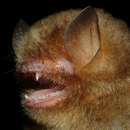Biology
provided by Arkive
The female papillose woolly bat gives birth to a single pup each year, which is suckled until it can fly and forage alone (5). Adults feed on small insects amongst the dense vegetation. They use echolocation to navigate their surroundings and to locate their prey. Repeated ultrasonic shouts are emitted which bounce off nearby objects, returning to the bat's ears as echoes. These echoes are interpreted by the bat's brain and a picture of its environment is built up (5).
Conservation
provided by Arkive
Deforestation for agriculture, particularly for oil palm plantations in recent years in Malaysia, Indonesia and Thailand, is an issue of major concern for many forest-dwelling species, even within so-called protected areas. Regarding oil palm, some companies and large retailers have agreed to source palm oil from sustainable sources via a certification process developed by the Roundtable for Sustainable Palm Oil. The principal criterion relevant to biodiversity is that new plantations have not been established on land of High Conservation Value (7). Many scientific and charitable groups contribute to bat monitoring and local education programmes that can help to reduce persecution and raise awareness of the natural assets of the land (9).
Description
provided by Arkive
This feisty species has relatively broad wings compared to many other similar-sized bats, a trait that allows it to be highly manoeuvrable. The wing membrane stretches between the hind legs, enclosing the tail. This is known as the interfemoral membrane, and is covered in small, soft, wart-like projections and is hairless (1). The face is pointy and lacks a noseleaf, having instead a simple muzzle. The bat must emit echolocation pulses through its mouth, exposing the sharp, pointed teeth that are used for crushing the tough exoskeletons of insects. The ears are large and wide-set; the forehead is large and rounded and the flap of skin within the ear, known as the tragus, is long and thin. The fur is dense, smooth and long, and is dark brown on the back, golden at the tips and brown at the sides. The feet are covered with long grey hairs. Bats currently referred to as papillose woolly bats exhibit large size variation and it is likely that more than one species is included. Small individuals in India, Malaysia and Borneo have recently been referred to as a separate species Kerivoula lenis (3) .
Habitat
provided by Arkive
The papillose woolly bat is found in primary, secondary and peat-swamp forests, where it forages beneath the lower canopy and roosts in hollow trees (5).
Range
provided by Arkive
This species has a large range in Asia, including northeast India, Thailand, Vietnam, Cambodia, Peninsular Malaysia, Sumatra, Java, Borneo and Sulawesi (4).
Status
provided by Arkive
Classified as Lower Risk / Least Concern (LR/lc) on the IUCN Red List (2).
Threats
provided by Arkive
Deforestation and forest fragmentation pose the greatest threat to the papillose woolly bat. The rapid increase in land devoted to commodity agriculture (such as cocoa, coffee, oil palm, rice and rubber) has resulted in extensive loss of forest in the last 20 years. In recent years, one of the largest agricultural drivers of deforestation in Malaysia, Sumatra and Thailand has been oil palm. Together, Malaysia and Indonesia export 88 percent of the world's palm oil, for use in products such as margarine, lipstick and detergent. In addition, despite the contribution of many bats in the control of insect crop pests, persecution of bats is also a threat (7) (8).
Papillose woolly bat
provided by wikipedia EN
The papillose woolly bat (Kerivoula papillosa) is a species of vesper bat in the family Vespertilionidae. It is found in Brunei, India, Indonesia, Malaysia, and Vietnam.
Appearance
The fur is typically dark brown on top, and lighter brown on the bottom. White hair is commonly found on the foot as well. This species has a unique interfemoral membrane. This membrane is hairless and is covered with small, soft, wart-like projections. The teeth are pointed and specialized for crushing the exoskeletons of insects.[2]
Ecology
Tree hollows are used for roosts, and generally have between 1 and 14 bats inhabiting them. The habitats inhabited are lowland mixed deciduous forests in the lower Asian peninsula.[3][4]
References
-
^ Hutson, A.M.; Kingston, T. (2021). "Kerivoula papillosa". IUCN Red List of Threatened Species. 2021: e.T10981A22020906. doi:10.2305/IUCN.UK.2021-1.RLTS.T10981A22020906.en. Retrieved 16 November 2021.
-
^ Corbet, G.B. and Hill, J.E. (1992) The Mammals of the Indomalayan Region: a systematic review. Oxford University Press, Oxford.
-
^ Hutson, A.M. & Kingston, T. 2008. Kerivoula papillosa. In: IUCN 2013. IUCN Red List of Threatened Species. Version 2013.1. www.iucnredlist.org
-
^ Simmons, N.B. (2005) Order Chiroptera. In: Wilson, D.E. and Reeder, D.M. (Eds) Mammal Species of the World: A Taxonomic and Geographic Reference, Third Edition. The Johns Hopkins University Press, Baltimore and London

- license
- cc-by-sa-3.0
- copyright
- Wikipedia authors and editors
Papillose woolly bat: Brief Summary
provided by wikipedia EN
The papillose woolly bat (Kerivoula papillosa) is a species of vesper bat in the family Vespertilionidae. It is found in Brunei, India, Indonesia, Malaysia, and Vietnam.
- license
- cc-by-sa-3.0
- copyright
- Wikipedia authors and editors

